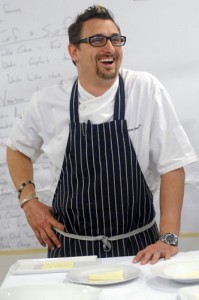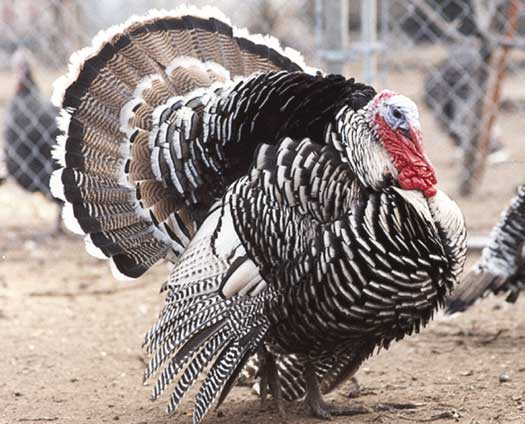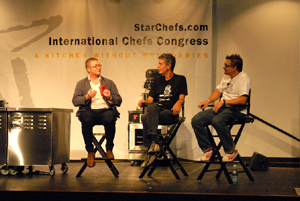
For those of you who want a taste of the Halloween Iron Chef America Battle Offal, well here it is. Take a look at Incanto to get all the answers on the what, when, where and hows. This is only available on Thursday, Friday and Saturday nights, since I will be cooking this menu by myself in the back kitchen.
]]>This was a great night of sake and tuna had by all 15 who attended, especially me because I chose to do this dinner on my birthday. The most amazing part about this dinner was the Kindai Tuna and how special it is, a true sustainable bluefin tuna. I never knew about this until the first discussions of cooking this dinner, absolutely great fish. I really enjoyed the opportunity to work with Michael and Danny I learned more about tuna in one night from them, then years in kitchens. How to cut it properly, age the fish and treat it in the Japanese style. I look forward to cooking with them again in the future, whats the next fish guys.
]]>Deluxe Nose-to-Tail Meals
Joshua M. Bernstein 2008-05-12 11:30:52.0

© Heath Robbins Photography
![]() LAUNCH SLIDESHOW
LAUNCH SLIDESHOW
Offal-y good ox hearts, lamb spleen and more
Colin Alevras, chef at New York City’s Tasting Room, recently unveiled a luxury burger that blew diners’ minds. While the $23 price tag is chump change compared to the $75 foie gras-stuffed, black-truffle-topped burger at NYC’s DB Bistro Moderne, what sets Alevras’ meaty masterpiece apart is not decadent toppings but the meat itself.
The Old MacDonald burger, as Alevras dubs it, blends a grass-fed cow’s heart, liver, bone marrow, tongue, flatiron, brisket, shank and clod. It’s topped with raw cow’s-milk cheese and “mushroom ketchup,” and it’s served on a beer-bread bun. Fries are, incidentally, extra.
“I haven’t seen anybody reconsider the burger from the cow up. We don’t hide behind its casualness. We are remaking the world’s most overlooked food,” the chef recently told NYmag.com’s food blog, Grub Street.
Is Alevras’ creative hamburger a weirdo anomaly? No way. Nowadays, chefs are branching out beyond meaty ribs or tender filet mignon to embrace a nose-to-tail eating ethos.
“If you’re going to kill the animal, it seems only polite to use the whole thing,” British chef Fergus Henderson famously wrote in his book “The Whole Beast,” which touted the tastiness of tripe, trotters and internal organs. While many diners prefer to forget their flank steak was carved from a mooing creature, high-end dining now features a new face. Plus some hearts. And, occasionally, intestines.
“Organ meats don’t have to mean Mom’s overcooked liver,” explains Andy Nusser, head chef at New York City’s Casa Mono. The tapas-style small-plates eatery, which is owned partly by Mario Batali, offers unusual cuts—such as lamb’s tongue, duck hearts and cock’s combs. The latter is the fleshy red cap atop a rooster’s head; at Casa Mono, it’s simmered with red wine and porcini mushrooms until fork-tender.
“We’re returning to using the whole animal,” says Nusser, who has taken to sourcing entire organic pigs. “You’re not just picking up a phone and ordering parts. This makes you want to use every last bit. You don’t want to throw anything out.”
Especially not the noggin. “I really enjoy cooking a pig head,” Nusser says. “I like slowly simmering it and pulling the meat off the head, then taking the liquid it was cooked in and turning it into gelatin. It’s a journey to look at an ugly pig’s head and turn it into a beautiful terrine.”
Nusser’s adoration of long-overlooked animal parts has company. At Portland’s Le Pigeon, diners can opt for “foot and tail” croquettes or duck-duck-pigeon—roast squab with duck confit salad and duck-liver vinaigrette. Boston’s KO Prime slings sautéed calves brains and bone marrow with oxtail marmalade. Philadelphia’s Ansell Food + Wine fashions a fine, crispy lamb’s tongue served with mint.
But perhaps America’s most adventurous nose-to-tail restaurant is San Francisco’s rustic-Italian Incanto. On offer are lamb’s necks, pig trotters and a five-course nose-to-tail tasting menu perhaps including venison kidneys and chocolate-blood panna cotta. For executive chef Chris Cosentino (who also runs www.offalgood.com), it’s not about Fear Factor-style extreme eating. “It’s about viable cuts of meat that we have thrown into the trashcan for years. There’s been lots of talk about sustainable eating, and offal is sustainable eating. If you buy leeks, do you just throw away the tops? Or do you use them to make broth? When it comes to food, we’re very wasteful.”
Historically speaking, America wasn’t always so wasteful. During World War II, thrifty cooks stretched their ration stamps by buying cuts of tongue. In the South, pig’s hooves, fried pork skin and chitterlings (a fancy word for pig intestines) have long been integral to Mason-Dixon Line cuisine.
“We’ve gone away from our history,” Cosentino says. “Years ago, a slaughter was a neighborhood affair. One guy would come around and slaughter one or two pigs, then someone would make blood sausage. And the casing was made from the pig’s intestines. People always ask me, ‘Why do you serve poor people’s food?’ That’s really disrespectful to the animal.”
For squeamish eaters, Cosentino suggests a “gateway” meat: beef hearts. “It’s a muscle, not a filter”—like liver or kidneys—“so it’s very rich and has lots of minerals. It changes people’s perceptions.”
Harder to alter are USDA guidelines. The government bans numerous victuals like lungs that Cosentino would love to toss into a skillet. “Cow’s udder is absolutely delicious—it’s a shame I can’t serve it,” he says. “Flavor-wise, it’s a mammary gland, so it’s very rich and fatty.”
Such is the crux of whole-animal eating: Creating luxury where it’s least expected. For this reason, “cooking nose to tail isn’t a fad; it’s never going to go away,” says Casa Mono’s Nusser. “The bottom line is that people that are trying hearts and organs are surprised to find that they’re delicious. Anyone can cook it. To cook a pig’s head, you just need a big pot. Just go to a butcher and ask them to split the pig head in half, then you’re halfway there.”
]]>
In preparation for Thanksgiving this coming Thursday my friend Jonnatan Levia and I spent our Sunday morning up in Sebasatapol helping slaughter heirloom breed turkeys with the 4-h kids and my good friend Jim Reichardt of liberty ducks.
The process was very simple each bird was brought over by its owner so it stayed calm, it was placed upside down in a cone to hold it. Once the incision was made the turkey bleed out in a few minutes, then it was tumbled in hot water to make the feathers easy to remove. The birds were hung by there feet and everyone helped pull feathers then over to the eviscerating table. The liver, heart and giblets were separated, as well as the testicles and pre eggs. Then the bird had its crop and intestines discarded then it was rinsed and deep chilled. All a very quick and amazing process I was glad to be a part of this.
Each family that raised these birds were there helping with the processing of the birds, making sure they were handled with care and tagged for their buyers from the slow food auction. It was an amazing experience to be there with families most non food professionals each person with a specific task in getting these birds clean and chilled asap. These birds were beautiful in so many ways, they were massive birds each with different plumage and colored feet, all unique breads from around the country. When it was all said and done there was about 60 birds prepared for the holiday. I can say I will be very thankful for my thanksgiving turkey this year since I picked him, then took him to the table start to finish. Thanks Jim for having me there it was a great learning experience.
Hungry Magazine has posted a video essay and photo journal of the evening from the kitchen prospective. Take a look at the video below or at Brightcove.tv. You can also check out the photo journal. Enjoy the video its a nice show of what the kitchen was like that day. And for those of you who joined us that evening thank you and I cant wait until next year.
]]>
Grist, 15 green chefs ]]>
You can vicariously experience the head-to-tail cooking of chef Chris Cosentino on his Web site, offalgood.com. Better yet, you can visit Incanto for a taste of his “fifth quarter” specialties like pig’s trotter cake and salt-cured pork liver. (1550 Church Street; 415-641-4500) ”
Andrew Knowlton, Bon Appétit, January 2007
The Restaurant Reporter:
Special Edition: From coast to coast, the hottest dining trends of the year

this photo is courtesy of: www.harlanturk.com
The first day I spoke on a panel called No Guts No Glory with Anthony Bourdain and Fergus Henderson. We had a large turn out with lots of questions. The biggest stink was from our responses to a question about the ban on foie gras. What a fucking joke that is. Apparently it’s OK to factory farm animals, keeping them in tiny pens, clipping their tails and beaks, feeding them inappropriate diets and pumping them full of drugs, but it’s not OK to feed an animal like its parents feed them when they are young. I dont get it.
The 2nd day, I taught a tripe workshop. I showed the difference between bleached and unbleached tripe. I had 3 different types of stomachs and showed 3 different cooking applications. Then we prepared and tasted a cold tripe salad. It was pretty fun.
Take a look at the overview of the ICC event, and plan on being there next year. With the amount of demos and lectures, it’s a huge educational opportunity for any chef or cook. I had a great time and I’ll definitely be back next year.
This is only a small expert from a 6 page article, so go out and get the magazine it shows that they are many chefs who work with these cuts of meat and the numbers are growing daily.
national culinary review 6/06